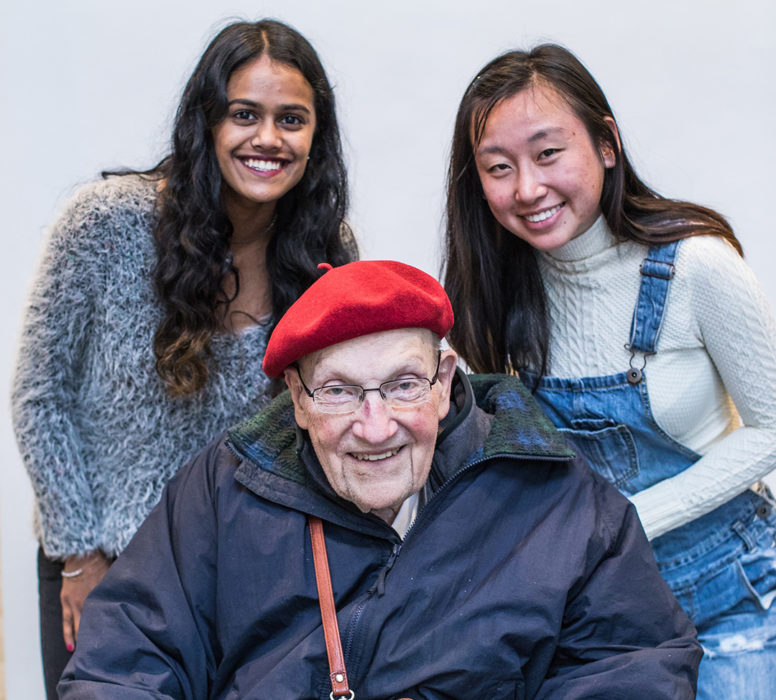CREATING COMMUNITY – In his younger years, Charles Francis was fearless and unconventional, open to trying new things, many of which he recounted in his memoir, “Encounters.” A writer and photographer for NASA and the Veterans Administration, he would regale his friends with stories of his travels and the unusual people he met.
Now 92, his interactions are largely limited to his partner, Mary Helen. Chronic back pain and walking problems have confined him to the house. When he isn’t waiting for visitors, he said he feels lonely.
“If you don’t have people around, you’re just sitting, waiting to die,” he said, staring out the window of his Haight district living room comfortably ensconced in his big leather chair.
Loneliness isn’t exclusive to older people or those with disabilities. But with the senior population growing, it’s an issue that’s caught the attention of health organizations and government agencies. There’s growing awareness of the impact of isolation and loneliness on health and health care costs.
Health and government officials are trying to get ahead of the game through intervention programs and studies. It’s not just an American problem, and the responses are varied. The United Kingdom last May created a Minister of Loneliness. In Japan, the Ibasho Café is a purposefully intergenerational project that brings together seniors and community members of all ages.
Solo time to Sunday night dinners
Francis, for example, is a participant in the Multimodal Intergenerational Social Contact Intervention (MISCI) study, which pairs two younger volunteers with a senior for three months of weekly visits. One of Francis’s visitors, Mahdu Manivannan, has become a friend. She joined Charles and Mary for some Sunday night sushi dinners. Her parents brought over an Indian meal to share. Now Manivannan and her parents have an open invitation to Sunday meals.
Although it’s hard to think about anything else when you’re in constant pain, Francis said, since signing up with MISCI, “I’ve felt livelier, more interested in life.” And he has a new audience for his stories.
In the U.S., these programs originate through city, state and federal governments, universities and health organizations, medical providers and nonprofits. Almost every project is collaborative and has multiple funding streams.
The MISCI study is through the Global Brain Health Initiative at the University of California-San Francisco’s Memory and Aging Center. It works in collaborations with community-based professionals at Openhouse, which serves LGBTQ seniors, and Little Brothers-Friends of the Elderly, through which Francis was recruited. Geriatricians, neurologists, and neuropsychologists at UCSF and Trinity College in Dublin, Ireland, are advisors to the program.
The impetus for these policies and programs is the belief that promoting social engagement and helping elders develop and maintain satisfying interpersonal relationships can forestall many adverse health outcomes.
It’s more than just medical care
“That’s what’s motivating all this talk of a public health crisis. It’s dependent on much more than medical care,” said Dr. Carla Perissinotto, associate chief of clinical programs in geriatrics at the University of California-San Francisco and an advisor to MIISCI. “Referrals to community programs are cheap … if they reduce calls and visits. It’s a wise investment. “
Francis was among the first people enrolled in the program, which began in 2018. It recently received two more years of funding from the San Francisco Department of Aging and Adult Services (DAAS), which will evaluate its effectiveness in reducing loneliness and social isolation.
Niche and neighborhood interests are another avenue to begin fostering connections. SF Connected, the San Francisco Public Library and City College offer free computer classes, including training in the use of social media to build connections. UCSF, Kaiser Hospital and The Friendship Line offer grief groups for the newly bereaved. There are telephone and online communities like Well Connected, intergenerational programs that match seniors with young adults, such as a recent Intergenerational Pop-Up sponsored by a local member of Global Shapers.
The DAAS-sponsored Village Program – San Francisco Village, NEXT Village – neighborhood Community Connector groups and Openhouse for the LGBTQ+ community offer opportunities for people to gather, for meals, exercise and other activities, and friendship. Even the people who deliver groceries and meals to seniors’ homes provide social connection where there might not otherwise be.
“Food is the key. It opens the door. When people need assistance, the first thing they accept is food,” said Ashley McCumber, CEO of Meals on Wheels. He runs the organization with the view that providing a human connection is just as important as a meal. “Isolation is the major challenge we face as a society. No robot, no app, Alexa, Hey Google or other technology can replace human connection.”
Facebook chats are not enough
DAAS recently increased funding to address social isolation through a variety of programs aimed at enhancing inclusion and reaching those without a social network, said Executive Director Shireen McSpadden.
“A growing body of research characterizes social isolation as a dangerous public health issue,” she said. “In San Francisco, one in four older adults lives alone and therefore may be at risk of isolation.“
Senior services in San Francisco have a long history of addressing loneliness – whether by creating programs that build community or that focus on putting individuals together.
“Anecdotally, it’s become a major focus in the last dozen years,” said Paul Downey, co-chair of the American Society on Aging’s Public Policy Committee. “For the last six or seven years, we’re particularly focused on the medical impact of loneliness, depression and isolation, when we realized their impact on health.”
But it’s not a new issue, he said. “We’re just more aware now of the problem. Sixty years ago, families were more connected; they lived closer to one another. Now, we’re more dispersed. Families communicate on Facebook, but it’s not the same.”

